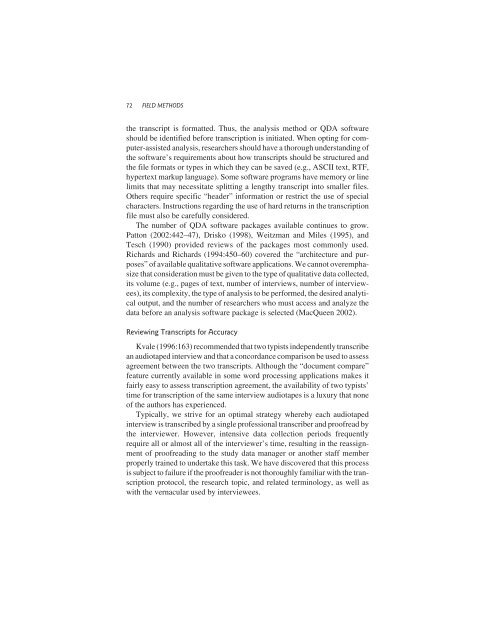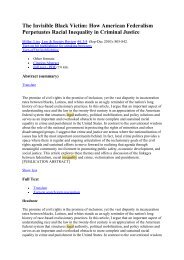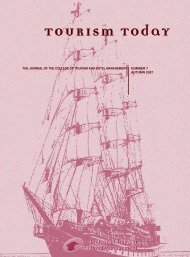Beyond the Qualitative Interview: Data Preparation and ... - E-Journal
Beyond the Qualitative Interview: Data Preparation and ... - E-Journal
Beyond the Qualitative Interview: Data Preparation and ... - E-Journal
You also want an ePaper? Increase the reach of your titles
YUMPU automatically turns print PDFs into web optimized ePapers that Google loves.
72 FIELD METHODS<br />
<strong>the</strong> transcript is formatted. Thus, <strong>the</strong> analysis method or QDA software<br />
should be identified before transcription is initiated. When opting for computer-assisted<br />
analysis, researchers should have a thorough underst<strong>and</strong>ing of<br />
<strong>the</strong> software’s requirements about how transcripts should be structured <strong>and</strong><br />
<strong>the</strong> file formats or types in which <strong>the</strong>y can be saved (e.g., ASCII text, RTF,<br />
hypertext markup language). Some software programs have memory or line<br />
limits that may necessitate splitting a lengthy transcript into smaller files.<br />
O<strong>the</strong>rs require specific “header” information or restrict <strong>the</strong> use of special<br />
characters. Instructions regarding <strong>the</strong> use of hard returns in <strong>the</strong> transcription<br />
file must also be carefully considered.<br />
The number of QDA software packages available continues to grow.<br />
Patton (2002:442–47), Drisko (1998), Weitzman <strong>and</strong> Miles (1995), <strong>and</strong><br />
Tesch (1990) provided reviews of <strong>the</strong> packages most commonly used.<br />
Richards <strong>and</strong> Richards (1994:450–60) covered <strong>the</strong> “architecture <strong>and</strong> purposes”<br />
of available qualitative software applications. We cannot overemphasize<br />
that consideration must be given to <strong>the</strong> type of qualitative data collected,<br />
its volume (e.g., pages of text, number of interviews, number of interviewees),<br />
its complexity, <strong>the</strong> type of analysis to be performed, <strong>the</strong> desired analytical<br />
output, <strong>and</strong> <strong>the</strong> number of researchers who must access <strong>and</strong> analyze <strong>the</strong><br />
data before an analysis software package is selected (MacQueen 2002).<br />
Reviewing Transcripts for Accuracy<br />
Kvale (1996:163) recommended that two typists independently transcribe<br />
an audiotaped interview <strong>and</strong> that a concordance comparison be used to assess<br />
agreement between <strong>the</strong> two transcripts. Although <strong>the</strong> “document compare”<br />
feature currently available in some word processing applications makes it<br />
fairly easy to assess transcription agreement, <strong>the</strong> availability of two typists’<br />
time for transcription of <strong>the</strong> same interview audiotapes is a luxury that none<br />
of <strong>the</strong> authors has experienced.<br />
Typically, we strive for an optimal strategy whereby each audiotaped<br />
interview is transcribed by a single professional transcriber <strong>and</strong> proofread by<br />
<strong>the</strong> interviewer. However, intensive data collection periods frequently<br />
require all or almost all of <strong>the</strong> interviewer’s time, resulting in <strong>the</strong> reassignment<br />
of proofreading to <strong>the</strong> study data manager or ano<strong>the</strong>r staff member<br />
properly trained to undertake this task. We have discovered that this process<br />
is subject to failure if <strong>the</strong> proofreader is not thoroughly familiar with <strong>the</strong> transcription<br />
protocol, <strong>the</strong> research topic, <strong>and</strong> related terminology, as well as<br />
with <strong>the</strong> vernacular used by interviewees.














